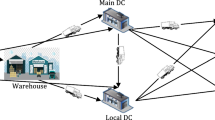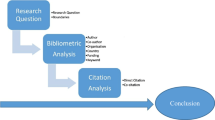Abstract
In this paper, we develop a global supply chain network model in which profit-maximizing firms engage in competition in the production and distribution of products in the presence of quantitative trade policy instruments in the form of tariff rate quotas. Tariff rate quotas are two-tiered tariffs, in which a lower in-quota tariff is applied to the units of imports until a quota or upper bound is attained and then a higher over-quota tariff is applied to all subsequent imports. They are utilized to protect domestic producers in the case of a wide range of products, from agricultural ones to fabrics and even steel, and can be challenging to formulate. We construct the governing set of novel equilibrium conditions associated with the product flows and Lagrange multipliers, which correspond to quota rent equivalents, and derive the variational inequality formulation. Qualitative properties are presented along with an effective algorithm, which is then applied to compute solutions to numerical examples comprising an agricultural product case study on avocados and global trade. This work is the first to model and solve general, competitive supply chain network problems consisting of oligopolistic firms with multiple production sites and demand markets in multiple countries subject to tariff rate quotas.








Similar content being viewed by others
References
Bishop, P.M., Nicholson, C.F., Pratt, J.E., Novakovic, A.M.: Tariff-Rate Quotas: Difficult to Model or Plain Simple? Trade Working Papers 22011. East Asian Bureau of Economic Research (2001)
Bradsher, K.: To understand a tax on Mexican imports, consider the avocado. The New York Times, January 27 (2017)
Cruz, I.: The avocado is the “green” gold of Mexico. abasto.cm, September 12. https://abasto.com/en/business-showcase/avocado-green-gold-mexico/ (2017)
Daniele, P.: Time-dependent spatial price equilibrium problem: existence and stability results for the quantity formulation model. J. Glob. Optim. 28(3–4), 283–295 (2004)
Daniele, P.: Evolutionary variational inequalities and applications to complex dynamic multi-level models. Transp. Res. E 46(6), 855–880 (2010)
Daniels, J.: Avocado sales could more than double this year, helped by demand from China’s middle class, cnbc.com. https://www.cnbc.com/2018/01/10/chinas-middle-class-is-boosting-demand-for-avocados.html (2018)
de Melo, J.: Bananas, the Longest Transatlantic Dispute in the World Trading System: A Post-Mortem. RSCAS Policy Paper 2015/07. European University Institute, Robert Schuman Centre for Advanced Studies Global Governance Programme, Italy (2015)
Donnan, S., Wasson, E.: New obstacles arise for the new Nafta. Bloomberg Businessweek, November 21 (2018)
Filloon, W.: Countries such as China and Mexico have introduced retaliatory tariffs on scores of American goods including coffee, pork, soybeans, and whiskey. EATER.com, September 24. https://www.eater.com/2018/7/18/17527968/food-tariffs-trump-canada-china-mexico-eu (2018)
freshplaza.com. China: Market price rises for avocados and grapefruit. https://www.freshplaza.com/article/2173014/china-market-price-rises-for-avocados-and-grapefruit/ (2017)
Gabay, D., Moulin, H.: On the uniqueness and stability of Nash equilibria in noncooperative games. In: Bensoussan, A., Kleindorfer, P., Tapiero, C.S. (eds.) Applied Stochastic Control of Econometrics and Management Science, pp. 271–294. North-Holland, Amsterdam (1980)
Gale, F.: U.S. challenge of Chinas tariff-rate quota (TRQ) administration system for grains. In: Selected Paper Prepared for Presentation at the International Agricultural Trade Research Consortium’s (IATRC’s) 2017 Annual Meeting: Globalization Adrift, December 3–5, Washington (2017)
gro-intelligence.com. Holy guacamole: How US consumption, Mexican production transformed the avocado industry. July 3. https://gro-intelligence.com/insights/holy-guacamole-how-us-consumption-mexican-production-transformed-the-avocado-industry (2015)
Guyomard, H., Le Mouel, C., Lever F., Lombana, J.: The tariff-only import regime for bananas in the European Union: Is setting the tariff at right level an impossible mission? Paper prepared for presentation at the XIth EAAE Congress (European Association of Agricultural Economists), Copenhagen, Denmark, August 24–27 (2005)
Kinderlehrer, D., Stampacchia, G.: An Introduction to Variational Inequalities and Their Applications. Academic Press, New York (1980)
Korpelevich, G.M.: The extragradient method for finding saddle points and other problems. Matekon 13, 35–49 (1977)
Larmer, B.: How the avocado became the fruit of global trade. The New York Times, March 27 (2018)
Li, D., Nagurney, A.: Supply chain performance assessment and supplier and component importance identification in a general competitive multitiered supply chain network model. J. Glob. Optim. 67(1), 223–250 (2017)
Li, D., Nagurney, A., Yu, M.: Consumer learning of product quality with time delay: insights from spatial price equilibrium models with differentiated products. Omega 18, 150–168 (2018)
Maeda, K., Suzuki, N., Kaiser, H.M.: An Economic Evaluation of the New, Agricultural Trade Negotiations: A Nonlinear Imperfectly Competitive Spatial Equilibrium Approach. Working paper, Department of Applied Economics and Management, Cornell University, Ithaca (2001)
Maeda, K., Suzuki, N., Kaiser, H.M.: Evaluating international agricultural policies using a dynamic nonlinear imperfectly competitive spatial equilibrium model. J. Fac. Agric. Kyushu Univ. 50(2), 767–790 (2005)
Manzo, P.H.: Implementation of tariff rate quotas in the Philippines. Ph.D. Dissertation, Kansas State University, Manhattan (2007)
Nagurney, A.: Network Economics: A Variational Inequality Approach, 2nd edn. Kluwer, Dordrecht (1999)
Nagurney, A.: Supply Chain Network Economics: Dynamics of Prices, Flows, and Profits. Edward Elgar Publishing, Cheltenham (2006)
Nagurney, A., Besik, D., Dong, J.: Tariffs and quotas in world trade: a unified variational inequality framework. Eur. J. Oper. Res. 275(1), 347–360 (2019)
Nagurney, A., Matsypura, D.: Global supply chain network dynamics with multicriteria decision-making under risk and uncertainty. Transp. Res. E 41, 585–612 (2005)
Nagurney, A., Yu, M., Besik, D.: Supply chain network capacity competition with outsourcing: a variational equilibrium framework. J. Glob. Optim. 69(1), 231–254 (2017)
Nash, J.F.: Equilibrium points in n-person games. Proc. Natl. Acad. Sci. USA 36, 48–49 (1950)
Nash, J.F.: Noncooperative games. Ann. Math. 54, 286–298 (1951)
Office of the United States Trade Representative. President Trump approves relief for U.S. washing machine and solar cell manufacturers. Washington DC, January. https://ustr.gov/about-us/policy-offices/press-office/press-releases/2018/january/president-trump-approves-relief-us (2018)
Qiang, Q., Ke, K., Anderson, T., Dong, J.: The closed-loop supply chain network with competition, distribution channel investment, and uncertainties. Omega 41(2), 186–194 (2013)
Saberi, S.: Sustainable, multiperiod supply chain network model with freight carrier through reduction in pollution stock. Transp. Res. E 118, 421–444 (2018)
Samuelson, P.A.: Spatial price equilibrium and linear programming. Am. Econ. Rev. 42, 283–303 (1952)
Shono, C.: WTO to Kokusai-Nuseihin-Boeki (The World Dairy Trade and WTO). Norin-lbkci-Kyokai, Tokyo (2001). (in Japanese)
Skully, D.W.: Economics of Tariff-Rate Quota Administration. USDA Economic Research Service, Technical Bulletin No 1893, April, Washington (2001)
Takayama, T., Judge, G.G.: Spatial equilibrium and quadratic programming. J. Farm Econ. 46(1), 67–93 (1964)
Takayama, T., Judge, G.G.: Spatial and Temporal Price and Allocation Models. North-Holland Publishing Company, Amsterdam (1971)
U.S. International Trade Commission: Economic impact of trade agreements implemented under trade authorities procedures, 2016 Report. Publication Number: 4614 Investigation Number: 332-555, Washington, DC (2016)
Watson, P.W.: Even if Trump’s tariffs are effective, there’s one reason they won’t work. Forbes, October 10 (2018)
World Trade Organization. Market access: tariffs and tariff quotas, December 1. https://www.wto.org/english/tratop_e/agric_e/negs_bkgrnd10_access_e.htm (2004)
World Trade Organization. Get tariff data. https://www.wto.org/English/tratop_e/tariffs_e/tariff_data_e.htm (2018)
Yu, M., Nagurney, A.: Competitive food supply chain networks with application to fresh produce. Eur. J. Oper. Res. 224(2), 273–282 (2013)
Zhang, D.: A network economic model for supply chain versus supply chain competition. Omega 34(3), 283–295 (2006)
Acknowledgements
The authors are grateful to the two anonymous reviewers and to the Editor for helpful comments and suggestions on an earlier version of this paper.
Author information
Authors and Affiliations
Corresponding author
Additional information
Publisher's Note
Springer Nature remains neutral with regard to jurisdictional claims in published maps and institutional affiliations.
Rights and permissions
About this article
Cite this article
Nagurney, A., Besik, D. & Nagurney, L.S. Global supply chain networks and tariff rate quotas: equilibrium analysis with application to agricultural products. J Glob Optim 75, 439–460 (2019). https://doi.org/10.1007/s10898-019-00794-x
Received:
Accepted:
Published:
Issue Date:
DOI: https://doi.org/10.1007/s10898-019-00794-x




